The Dell Venue 10 7040 Review
by Brandon Chester on June 30, 2015 8:00 AM ESTDisplay
Because tablets are essentially large displays that you hold and interact with, it's very important that display quality is prioritized when designing a tablet. Based on the disappointing display performance of the Dell Venue 8, I was concerned about how well the Venue 10 would perform. Both devices have 2560x1600 AMOLED displays, with the Venue 8 being 8.4" in size and the Venue 10 being 10.5" in size. However, because the Venue 10 is a newer product with a different panel, it's very possible that it will have different attributes than the Venue 8.
Before getting into the display measurements, I thought it would be important to mention something special about the Venue 10's display. Since the Venue 10 has a larger size and the same resolution, one might expect that it's not as sharp as the Venue 8. However, there's an important difference between the two that isn't made clear based on the resolution. While the Venue 8 uses a PenTile RGBG subpixel arrangement, the Venue 10 uses a subpixel array with a red, green, and blue subpixel for each pixel. On Samsung tablets this has been called an S-Stripe subpixel arrangement, and although I can't confirm that this display is made by Samsung, it seems fairly likely given the fact that the sizes, resolutions, and subpixel arrangements mirror those of Samsung's own tablets.
While the Venue 10 has only 287 pixels per inch, the RGB-ish subpixel arrangement makes it appreciably better at rendering text than the Venue 8. On the Venue 8 I noticed significant artifacting on the edges of small text, such as the labels for app icons in the launcher. In these same situations the Venue 10 is very sharp and isn't aliased at all. Ultimately, despite what the specs say on paper, the Venue 10 has a sharper display than its smaller sibling.
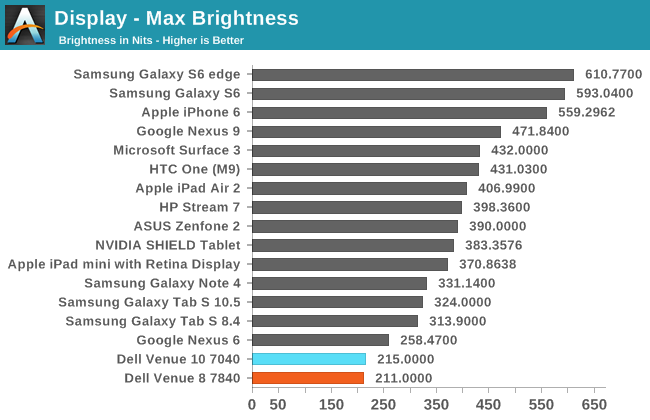
Our first test is the maximum brightness of the device. As you can see, at 100% average picture level the maximum brightness is right in line with the Venue 8, which makes it close to the lowest brightness of any device we've tested in recent years. It's really difficult to use the display outside, and using it as a laptop with unforgiving lighting can also be straining.
Because AMOLED displays are able to turn pixels off, they are able to drive a higher brightness with a lower APL while staying within their target power usage. The Venue 10 will go up to 343 nits when only 10% of the display is lit. Based on our previous testing, the average APL for a Material Design app or a web page is around 80%. Even so, the Venue 10's brightness of 252 nits in that scenario is still quite low.
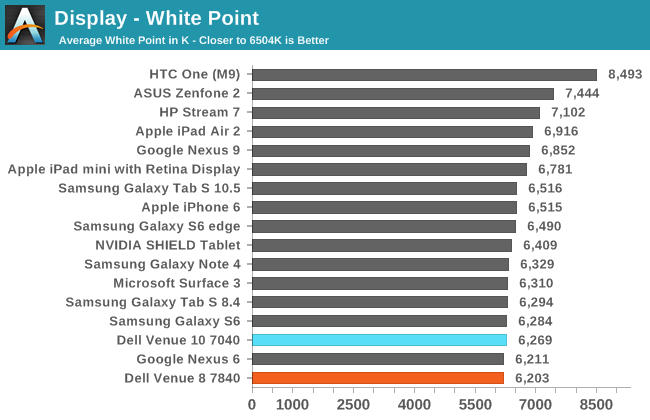
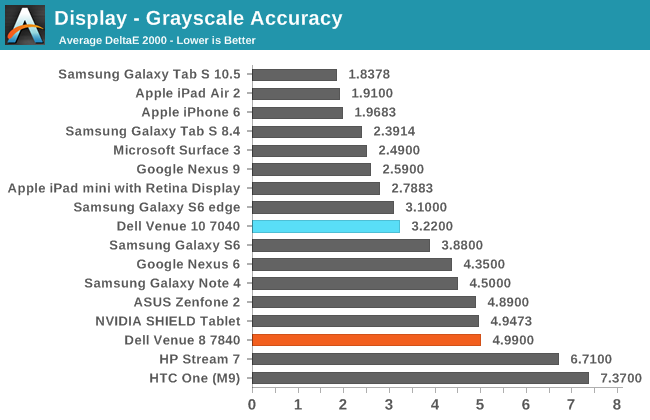
Greyscale performance on the Venue 10 is improved significantly over the Venue 8. While the display still exhibits a red shift, it's not as severe as the Venue 8. With a DeltaE of 3.22, the Venue 10 is almost as accurate as the Galaxy S6 Edge which has been highly praised for its display accuracy. The gamma is too low, which causes the display to move too quickly from dark to light. However, this can actually work in the display's favor by dulling the appearance of colors slightly to offset some of the saturation issues that you can see below.
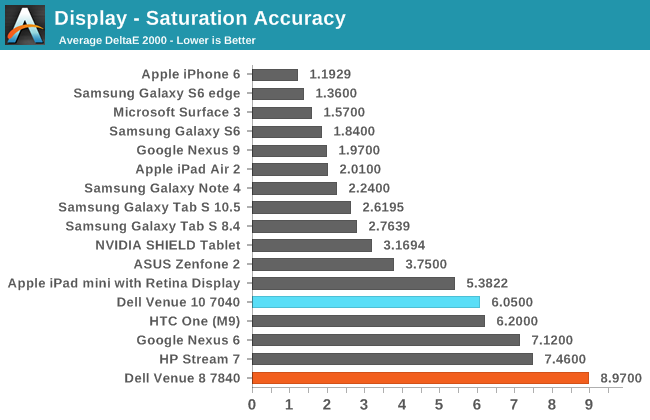
In our saturation test, the Venue 10 performs better than the Venue 8, but is still far from accurate. and comes in with the highest DeltaE of any device that we've tested in recent times. The inaccuracies in blue and magenta have been improved significantly, but the other primary and secondary colors are still highly oversaturated. The low gamma and improvements result in the issues being less pronounced as they were on the Venue 8, but the oversaturation is still very apparent throughout the Android interface. Content designed for the sRGB gamut looks very inaccurate.
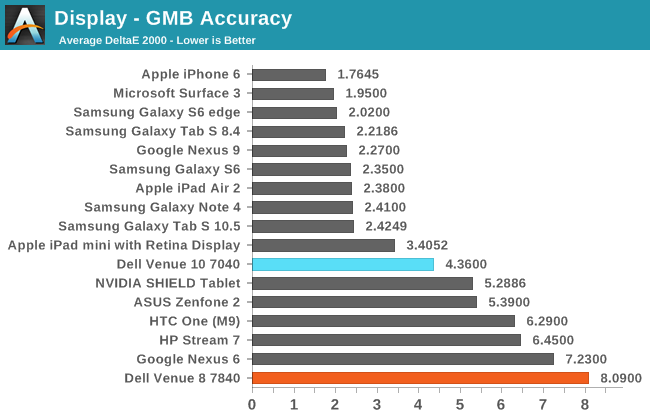
The Gretag MacBeth ColorChecker test measures the accuracy of various shades of grey and colors that occur within nature. In this test we see a significant improvement over the Venue 8's display. However, much of the improvement is due to the increase greyscale accuracy, with many colors still being rendered incorrectly. Colors in the orange region of the chromaticity chart, including skin tones, still suffer from a high degree of inaccuracy.
The Venue 10's display is undeniably an improvement over the display on the Venue 8. However, it's still not competitive with the displays on other flagship tablets like the iPad Air 2 and the Nexus 9. AMOLED devices that aren't produced by Samsung still suffer from the same issues with color rendering and low brightness. The improvements to greyscale accuracy and the use of a non-PenTile subpixel array are greatly appreciated, but the Venue 10's AMOLED display is not at the same level as those on Samsung's devices, or the IPS displays on other flagship tablets.



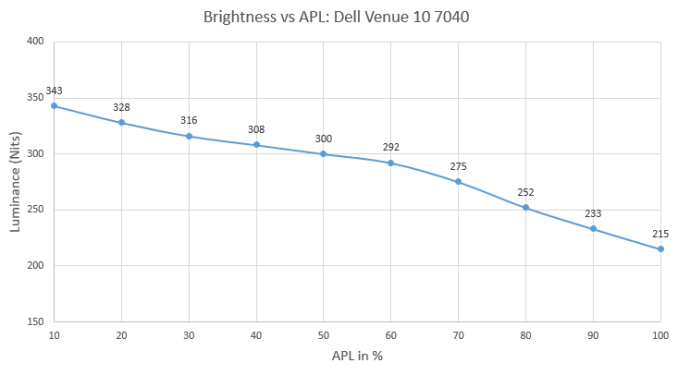
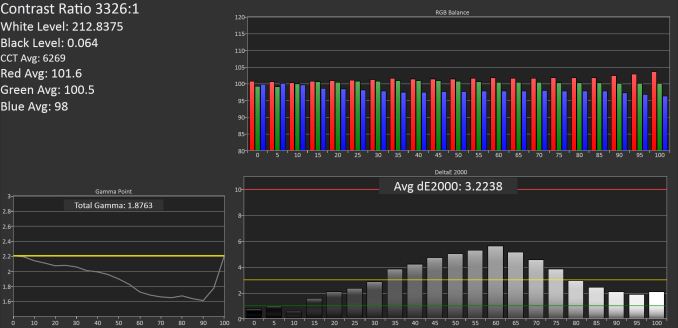

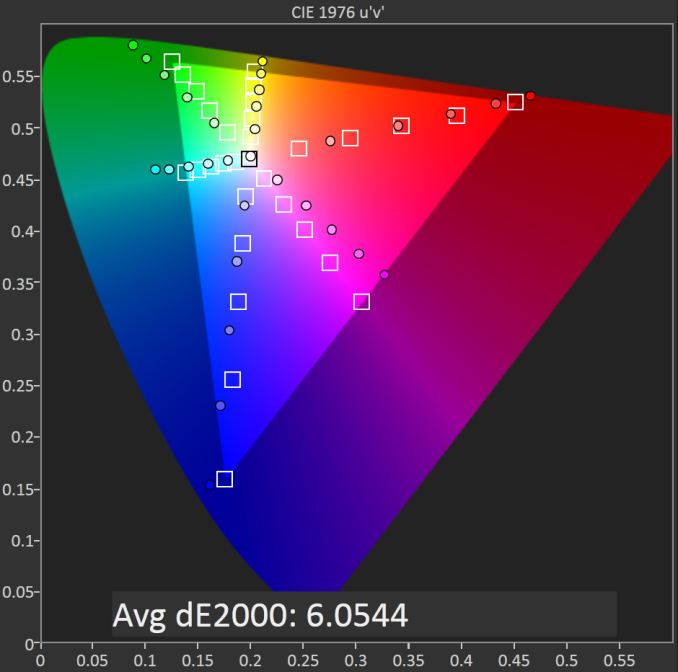










49 Comments
View All Comments
tsk2k - Tuesday, June 30, 2015 - link
When is the Carrizo review coming out?DigitalFreak - Tuesday, June 30, 2015 - link
I'll save you 8 pages of reading.It sucks.
Hulk - Wednesday, July 1, 2015 - link
Thanks you just saved me 15 minutes. And I'm being totally serious.kyuu - Thursday, July 2, 2015 - link
Can you and the other members of the AMD-hate circle jerk kindly stop infesting the comment section here? Anandtech is a site for people who want to read about tech, not indulge in mindless dickery. Thanks.maglito - Monday, July 6, 2015 - link
Probably when you can actually get a carrizo powered laptop / 2in1. Have you seen any for sale yet? I haven't, and I've been looking. I really want a laptop with 18Gbps HDMI (2.0) and hardware H.265 decode. They were supposed to be available by now....nightbringer57 - Tuesday, June 30, 2015 - link
About the 2 in 1 aspect...I feel the problem of this market niche is the harsh competition from windows 8.1 (soon to be 10) "Tabletbooks" (2 - 1 tablet + netbook devices like the asus T100). Those are really common and you can get very good models around 200-300€. You can really put the keyboard to full use with the (almost) full-fledged Windows compatibility. If you're gonna buy a not-so-good tablet just because it can make an awesome netbook when you need it, those models kick in and ass.
JeremyInNZ - Tuesday, June 30, 2015 - link
The Sony Z4 tablet is arguably the best 10" Android tablet on the market. It also comes with a keyboard doc, and does a much better job then the Dell with it. Just because Dell did a poor job of implementing the idea, does not make it a bad idea.zimanodenea - Tuesday, June 30, 2015 - link
Intel + PowerVR. I'd rather eat dog poop than buy into this combination again.lilmoe - Tuesday, June 30, 2015 - link
What were you expecting? We all know that last generation ATOM's iGPUs suck (and the current x7 sucks a little less). Wait for a $499 Core M tablet if you want something "interesting", and make sure it doesn't go above 1080p if you want 10+ hours of battery life...Samus - Wednesday, July 1, 2015 - link
The elephant in the room here is that this is a $500 Android tablet. $500. Starting price. If it were running Windows this would be a legitimate competitor to the Surface 3.The reality is you can buy two really decent Android tablets for the same price as this, specifically the Asus Transformer. This is basically a $200 Nextbook Ares (includes keyboard) for triple the price. I don't know what Dell is doing here. Covering something in Aluminum doesn't triple its value.